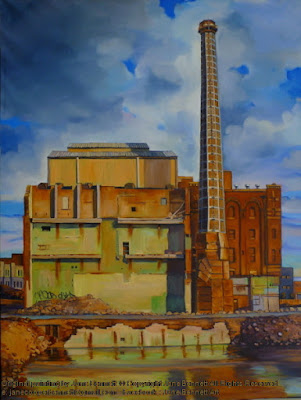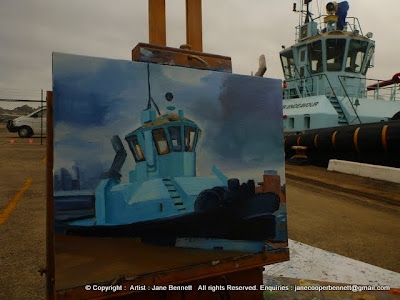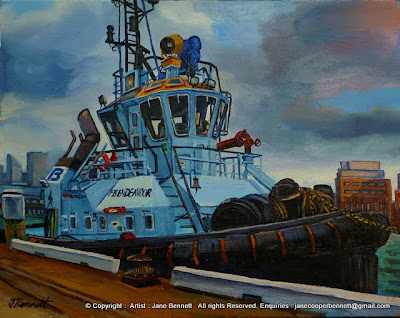Victoria st 2009 oil on canvas 75 x 100cm
In December 2009 I was asked by some people who worked at St Vincent's if I could create paintings of some terrace houses on a Darlinghurst block adjacent to St Vincent’s Public Hospital. Almost an entire block of Victoria Street between the Garvan Institute and the Green Park Hotel would be replaced by the construction of a new 11-storey medical centre.

'Victoria Street mural and the clinic'
2010 oil on canvas 38 x 76cm
Enquiries
The structures on this side of Victoria Street included the RMO, the Diabetes Centre, the Rankin Court Clinic for Drug and Alcohol treatment and a bright green mural which honoured World Aids Day.
For another view of this now destroyed mural see the post "Monday Mural" on the fascinating blog of Sydney Eye
 |
| "Victoria st -The World AIDS Day Mural between the Green Park Hotel and Rankin Court" 2010 oil on canvas 36 x 46cm Enquiries |
By the time that I started this series of paintings, these services were in the process of being relocated to neighbouring buildings. By mid 2010, the breakthrough new cancer treatment Centre, the Kinghorn Centre, was already under construction.
Victoria st terraces-The Mural to honour 'World AIDS Day'
2009-10 Ink, gouache on paper 43 x 61cm
Enquiries
The Kinghorn Centre, which will be opened in June 2012, is a joint Garvan Institute and St Vincent's Hospital project. It will pioneer a revolutionary method of customizing patient treatment instead of the previous one-drug-fits-all approach.
In early December 2011, cancer survivor Delta Goodrem, who is the patron of the Kinghorn Centre, spoke to assembled staff and construction workers at its launch .
See articles:"Delta Goodrem helps break ground on cancer centre" ; Article in Daily Telegraph

'A Corinthian column, St Vincents' De Lacy wing'
2011 oil on canvas 20 x 20cm
My aim was to paint
the exciting transition of the area from past to future. I painted all
the works in this exhibition on site, sheltering under the awnings of
the local restaurants and coffee shops, whose staff would keep an eye on
my easel and belongings.
From the Green park Bandstand, I
painted the classical facade of St Vincent’s heritage De Lacey wing
framed by ferny canopies of lime green trees.

'An Ionic column, St Vincents' Public Hospital,
De Lacy wing' 2011 oil on canvas 20 x 20cm
Some of these buildings have heritage value, and all of them are regarded with genuine affection by the locals. Most of the architecture of this block has been compromised to a greater or lesser extent by tasteless modern extensions, but taken as a whole, they express the character of a colourful and unique area of Sydney street-life.
"Victoria st terraces-The RMO "
2009-10 oil on canvas 46 x 36cm
Enquiries
The area is colourful and picturesque with a great diversity of buildings: from garish to subdued; from shabby to plush - and the characters who live, work and visit this area, rival the buildings for diversity and raffish charm.
"Victoria st terraces Nos 372-4 -
the Diabetes Centre & the RMO"
2009 oil on canvas 51x41cm.
SOLD Enquiries
Victoria Street is a
peculiar mélange of architecture ranging from the charming, to the
quirky, to the downright hideous.
Hole-in-the-wall coffee bars contrast with
the sleek corporate steel and glass of the Victor Chang Institute in the
background.
In between a few examples of faded glamour it's scruffy and
noisy but the place feels busy and vibrant.
An oasis of calm in all
this frenetic activity is Green Park.
"Victoria st terraces-Diabetes Australia"
2009 oil on canvas 31x31cm.
SOLD Enquiries
English colonial grandeur rubs
shoulders with crumbling terraces overgrown with vines and painted in
brightly sub-tropical hues.
"Victoria st terraces-The RMO"
2009-10 Ink, gouache on paper 63 x 41cm
Enquiries
My paintings of the buildings of this demolished block of Darlinghurst terraces honour the memories of the past, while celebrating the exciting possibilities of the future.
My exhibition will be held at the Xavier Art Space, Level 3 (which is the ground floor entry level) in the foyer of the St Vincent's Public Hospital. The Exhibition period is from 4 February - 8 March 2012, with the official opening on Tuesday night the 7th of February from 6-8pm. The works will be able to be viewed during the general hospital opening hours.
I am represented by the FRANCES KEEVIL GALLERY mob: 0411 821550
info@franceskeevilgallery.com.au
The Director, Frances Keevil will be curating and hanging the exhibition.
For more information about my paintings of the Victoria Street Terraces see my Urban Landscape Page






























